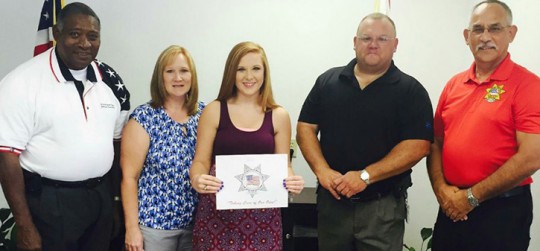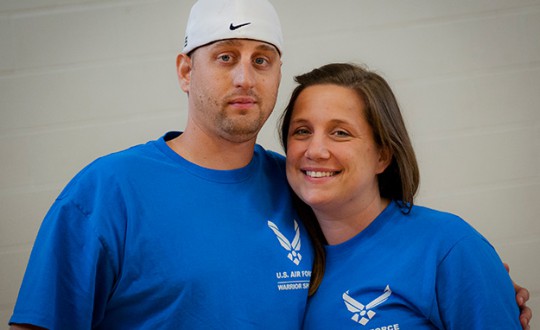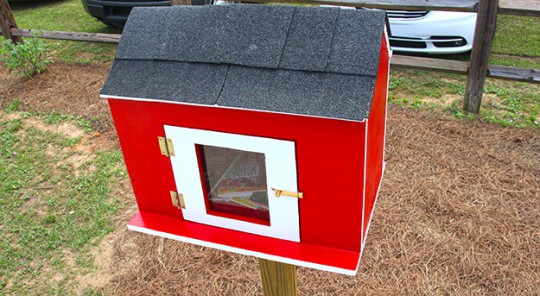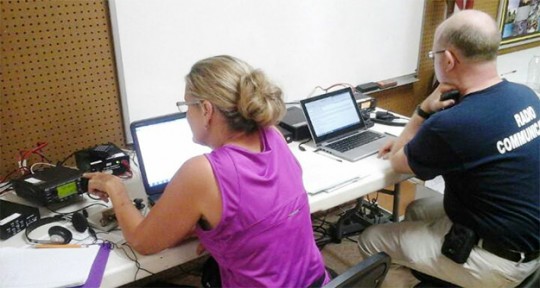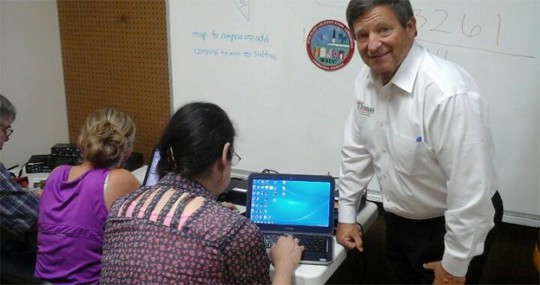Northview Graduate Bryan Receives Correctional Peace Officers Scholarship
July 1, 2015
Northview High School graduate Megan Bryan has received a scholarship from the Correctional Peace Officers Foundation. Bryan, who plans to attend Jefferson David Community College, was presented the scholarship Tuesday at Century Correctional Institution. On hand for the presentation were CPOF John Williams, mother Carrie Bryan, Megan Bryan, Warden Doug Sloan and CPOF Representative Gerard Van Der Ham. Submitted photo for NorthEscambia.com, click to enlarge.
Council on Aging Offers Cool Tips For Beating The Heat
June 29, 2015
As summer approaches and temperatures begin to rise, the elderly will be particularly vulnerable to heat-related illnesses like heat stroke and heat exhaustion.
According to the Centers for Disease Control, older adults, especially those taking medications that impair the body’s ability to regulate temperature, should be aware of the following cool tips for beating the heat:
- Stay in air-conditioned buildings as much as possible.
- Do not rely on a fan as your primary cooling device during an extreme heat event.
- Drink more water than usual and don’t wait until you’re thirsty to drink.
- Check on a friend or neighbor and have someone do the same for you.
- Don’t use the stove or oven to cook—it will make you and your house hotter.
- Wear loose, lightweight, light-colored clothing.
- Take cool showers or baths to cool down.
- Check the local news for health and safety updates.
- Seek medical care immediately if you have, or someone you know has, symptoms of heat-related illness like muscle cramps, headaches, nausea or vomiting.
Older adults and their caregivers are also encouraged to learn the signs and first aid response for heat-related illnesses. Warning signs may include:
Heat exhaustion symptoms:
- Heavy sweating
- Weakness
- Skin cold, pale and clammy
- Weak pulse
- Fainting and vomiting
If heat exhaustion symptoms are present:
- Move to a cooler location.
- Lie down and loosen your clothing.
- Apply cool, wet cloths to as much of your body as possible.
- Sip water.
- Seek medical attention if you have vomited and it continues.
Heat stroke symptoms:
- High body temperature (above 103 degrees F)
- Hot, red, dry or moist skin
- Rapid and strong pulse
- Possible unconsciousness
If heat stroke symptoms are present:
- Call 911 immediately – this is a medical emergency.
- Move the person to a cooler environment.
- Reduce the person’s body temperature with cool cloths or a bath.
- Do NOT give fluids.
For more information on how you can protect yourself against heat-related illnesses, call Council on Aging of West Florida at 850.432.1475.
Have You Registered Your Emergency Contact Info?
June 29, 2015
Florida’s Emergency Contact Information system reached a milestone this week, surpassing the 10 million mark in the number of people who have securely registered their contact information with the state. That’s an average of more than a million new registrants a year since the system was created in
 “The response we’ve seen from Floridians has been tremendous, but there are still more than five million licensed drivers who have not registered their emergency contact information,” said DHSMV Executive Director Terry L. Rhodes. “ECI provides you with a safe and secure way to register your contact information so that authorities can reach your loved ones when it matters most. It takes just a few minutes to register.”
“The response we’ve seen from Floridians has been tremendous, but there are still more than five million licensed drivers who have not registered their emergency contact information,” said DHSMV Executive Director Terry L. Rhodes. “ECI provides you with a safe and secure way to register your contact information so that authorities can reach your loved ones when it matters most. It takes just a few minutes to register.”
The ECI program was established in 2006 and immediately garnered national recognition. The idea for ECI came from Christine Olson, whose daughter, Tiffiany, was killed in a traffic crash on US 19 in Manatee County more than nine years ago. It was several hours after Tiffiany’s death before authorities were able to find her contact information and notify her parents. Her mother didn’t want other families to experience a similar fate and began pushing for the creation of a system that allows people to submit their emergency contact information as part of their secure driver license or identification card record. The information can only be accessed by law enforcement in times of an emergency.
“Ten years ago my life changed forever with my daughter’s death. I did not have the opportunity to say goodbye to Tiffiany,” said Christine Olson. “I didn’t want her death to be in vain. I began working to create a program to help other families so that they might avoid what my family experienced. I am pleased to hear that 10 million people have taken advantage of the Emergency Contact Information system.”
If you have already registered, be sure to keep your emergency contact information current. To register or update your information, go to: https://services.flhsmv.gov/eci/
Caregivers Mirror Wounded Warrior Struggles
June 28, 2015
Megan Fugitt was enjoying life as a newly-wed when in an instant, she went from being a wife to a caregiver.
Fugitt’s husband, Chris, a former Airman with the 96th Maintenance Squadron at Eglin Air Force Base, was on the mend of a kidney renal infarction in 2013 when he suddenly suffered a stroke as a result of blood thinners he was taking for his condition. The entire right side of his body was immediately paralyzed.
“He was wheelchair bound, couldn’t talk, couldn’t feed himself. He couldn’t do anything for himself without me,” said Fugitt, 28. “He had to relearn to do everything.”
To make matters worse, Chris had a pre-existing heart condition that made him susceptible to additional illnesses. Shortly after his stroke, he suffered through endocarditis, an inflammation of the inner layer of the heart, and an infection in his stomach, both resulting from cat scratch fever.
“He had to have a heart valve replacement, then open heart surgery. He recovered from that, did all sorts of rehab, and then had surgery to fix the stomach infection,” she said.
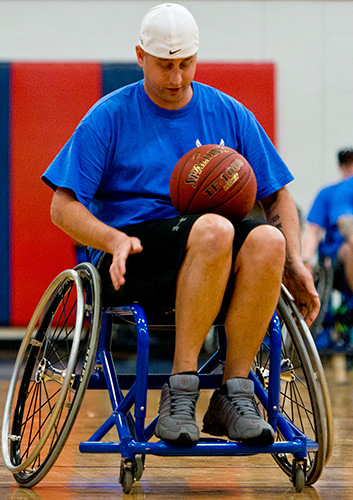 Since then, Fugitt’s life hasn’t been remotely similar to the one she once knew.
Since then, Fugitt’s life hasn’t been remotely similar to the one she once knew.
“I had to quit working, because there was no time between his appointments. He has five to 10 appointments every week, and they’re anywhere from here to Pensacola, Panama City and Birmingham.”
Chris’s regular rehabilitation regiment includes speech, physical, occupational and mental-health therapy.
“As his caregiver, I help him out with everything. We also have a son who was two at the time – he’s four now,” said Fugitt. “[Chris] was the dad who was very involved, and now it’s me taking care of our family, because he’s not able to.”
Her husband’s recovery care coordinator suggested he participate in the Air Force’s Wounded Warrior Program introductory adaptive sports and rehabilitation camp here to help in his recovery process. Little did Fugitt know, the camp would benefit her as well.
“Since we’ve been here, one thing that’s been really nice is he’s in this place where he’s able to feel comfortable with other people. Most of the time, I’ll go and run errands, and he’ll call and text me asking me when I’ll be home,” she said. “Finally, I’ve had my own time to just relax and not worry if something’s wrong with him, because I know he’s in a good place.”
The program provides support to caregivers of wounded warriors through activities scheduled during the camp to allow for them to have some time away from their hectic lives.
“The caregivers are the mirror to the warriors’ life changing experiences,” said Tonya McGough, Air Force Wounded Warrior caregiver program manager. “If they can’t keep their warriors positive and on the go to where they can transition to a new normal, then that’s when the chaos starts. If the warriors are good, then the caregivers are good.”
Throughout the camp, caregivers were afforded opportunities to break away from their busy schedules and focus on themselves through “me time” activities. Caregivers participated in a museum tour, yoga, water sports and a peer forum.
“Activities such as the peer forums are Air Force-wide and were developed for the caregivers as an outlet, so they have a place to go to connect with other caregivers with similar stories from across the world,” said McGough.
“It’s a healing process for the caregivers as well. When they’re struggling, they tend to hold on to things, and they don’t have an outlet or the opportunity to talk to anyone. We have many resources for them to open up,” she said.
Caregivers are also provided access to supporting agencies such as family services, employment assistance, financial support and resiliency counseling. Many of the services are offered virtually to increase accessibility to caregivers who may be otherwise unable to attend.
“These caregivers and warriors have a long fight, and I know they can do this on their own,” said McGough. “When they have the support of their leadership and their families, that helps give them the courage to move forward and not look back.”
The Fugitts plan to continue to participate in the camps, to include going as far as getting the different sports equipment needed for the activities Chris is interested in, so he can practice from home in the meantime.
“We finally found some people who are in the same area of life that we are. It’s absolutely amazing to be around other people that know what’s going on,” said Fugitt. “It feels like our life is going to move on. There’s actually something to look forward to.”
By Jasmine Porterfield
USAF photos by Samuel King Jr. for NorthEscambia.com, click to enlarge.
Little Free Library Available At Carver Park In Cantonment
June 28, 2015
A Little Free Library is available in Carver Park in Cantonment.
The concept is simple….pick up a book or two, and return another book or two to share. The Cantonment Little Free Library is located next to Carver Park Resource Center at 208 Webb Street. The Little Library is stocked with children’s books and more.
Several improvements were recently unveiled at Carver Park, including a renovated community resource center, enlarged parking lot, volleyball court and re-striped basketball court. The park will also soon feature a new pavilion for family and local events. The improvements began in 2014 and were funded to Local Option Sale Tax dollars.
Much of the work at Carver Park has been spearheaded by the Cantonment Improvement Association, a group working, as their name implies, to improve the quality of life for all law-abiding citizens of Cantonment, with an emphasis on making sure children and safe and well-prepared.
Editor’s note: The Cantonment Little Free Library is not maintained or affiliated with the West Florida Library. West Florida Library books cannot be returned to the Little Free Library.
NorthEscambia.com photos, click to enlarge.
Hams Demonstrate Amateur Radio Emergency Communications
June 28, 2015
It’s Amateur Radio Week, and the Five Flags Amateur Radio Association held a 24-hour public demonstration of emergency communications this weekend.
The public had a chance to meet and talk with Escambia County ham radio operators and see for themselves what the Amateur Radio Service is about as hams across the country held field days this weekend. Visitors were able to learn how ham emergency communications work, see the new capabilities of ham radio and learn how to obtain their own FCC radio license before the next disaster strikes.
Escambia County ham radio operators, as part of Amateur Radio Emergency Service (ARES), have provided emergency communications support to Escambia County Emergency Management, the America Red Cross and other agencies for several years. They were on duty during Hurricanes Ivan and Katrina, during other hurricanes, the major flooding event, and most recently during the winter ice storm of 2014.
The field day was held at Escambia Search and Rescue, 9530 Nims Lane, just off Nine Mile Road.
Pictured: Amateur radio field day at Escambia Search and Rescue Saturday. Pictured below: Escambia School Superintendent Malcolm Thomas stopped by to learn more about amateur ham services. Photos courtesy Jim Walters, ESAR, for NorthEscambia.com, click to enlarge.
Sheriff’s Office To Host Church Safety And Security Workshop
June 28, 2015
The Escambia County Sheriff’s Office is inviting all ministers and concerned church members to attend a special conference on “Security in the Place of Worship” next week.
“Our places of worship should be regarded as safe havens where the community can worship and experience fellowship free from worries about violence, theft or unethical behavior,” said Sheriff David Morgan, “I encourage all citizens to arm themselves with the knowledge necessary to prevent fraud, theft and other crimes.”
The workshop is free and is designed to assist citizens in their efforts to reduce crime in our places of worship and in their communities. The event will be held on Thursday, July 2 at 6 p.m. at the ECSO Main Administration Building at 1700 West Leonard Street.
To register, call Deputy Delarian Wiggins at (850) 436- 9705.
Pictured: The McDavid United Methodist Church. NorthEscambia.com photo.
Weekend Gardening: Tomato Pests
June 27, 2015
June is prime time for growing tomatoes here in Escambia County, but it’s also the best time to see a lot of pests in tomatoes that can totally ruin a crop. To help you figure out what’s “bugging” your tomatoes, here’s a quick rundown of some of the pests that you might see in your garden. Much of the information in this article was adapted from the University of Florida EDIS (Electronic Data Information Source) publication Insect Management for Tomatoes, Peppers, and Eggplant. Management techniques for the pests will be found in the full publication.
Click any photo to enlarge.
Silverleaf Whitefly
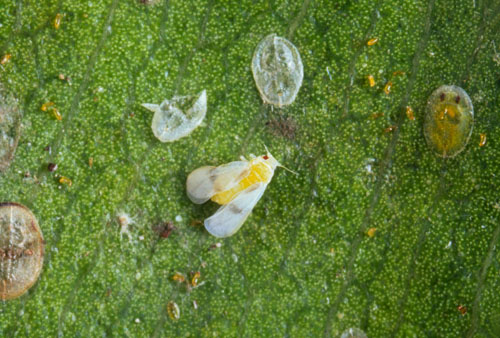 The adult silverleaf whitefly is small, approximately 1/16 of an inch in length, and has powdery white wings held tent-like while at rest over a yellow body. Whiteflies are usually found on the undersides of leaves. Eggs, which are yellow and football-shaped, are attached upright by a tiny stalk inserted into the lower leaf surface. A mobile first instar (growth stage), or crawler stage, hatches from the egg and settles on the leaf. It then develops through immobile second, third, and fourth instars which look like semi-transparent, flat, oval scales. The fourth instar or “pupa” is more yellow and more easily seen without the aid of a hand lens, and typically has very distinct eyespots, and is referred to as a “red-eyed nymph.”
The adult silverleaf whitefly is small, approximately 1/16 of an inch in length, and has powdery white wings held tent-like while at rest over a yellow body. Whiteflies are usually found on the undersides of leaves. Eggs, which are yellow and football-shaped, are attached upright by a tiny stalk inserted into the lower leaf surface. A mobile first instar (growth stage), or crawler stage, hatches from the egg and settles on the leaf. It then develops through immobile second, third, and fourth instars which look like semi-transparent, flat, oval scales. The fourth instar or “pupa” is more yellow and more easily seen without the aid of a hand lens, and typically has very distinct eyespots, and is referred to as a “red-eyed nymph.”
As the plant grows, leaves bearing the maturing nymphs are found lower down on the plant, so older nymphs can be found by looking at older leaves. Whiteflies ingest sap from the plant vascular system (phloem) through stylets similar to those of aphids and, like aphids, process a relatively large volume of plant sap by excreting excess liquid in the form of a sugary substance called honeydew. The honeydew will result in sooty mold—a black, powdery looking substance that reduces photosynthesis in the leaves. Sometimes the nymphs will feed on the fruit and that will cause white tissue on the inside of the fruit walls.
Aphids
 Aphids are soft-bodied, sucking insects that can rapidly colonize plants due to their short life cycle. Adults are delicate, pear- or spindle-shaped insects with a posterior pair of tubes (cornicles), which project upward and backward from the end of the abdomen and which are used for excreting a defensive fluid. In Florida, winged and wingless forms are all female and give birth to living young (nymphs). Nymphs are smaller but otherwise similar in appearance to wingless adults, which they become in 7 to 10 days.
Aphids are soft-bodied, sucking insects that can rapidly colonize plants due to their short life cycle. Adults are delicate, pear- or spindle-shaped insects with a posterior pair of tubes (cornicles), which project upward and backward from the end of the abdomen and which are used for excreting a defensive fluid. In Florida, winged and wingless forms are all female and give birth to living young (nymphs). Nymphs are smaller but otherwise similar in appearance to wingless adults, which they become in 7 to 10 days.
Heavy aphid infestations may cause stunting and leaf distortion. Feeding on blossoms reduces fruit set. Sooty mold will grow on the honeydew that the aphids excrete. Aphids may also spread plant viruses.
Brown and Green Stink Bugs and Leaf-footed bugs
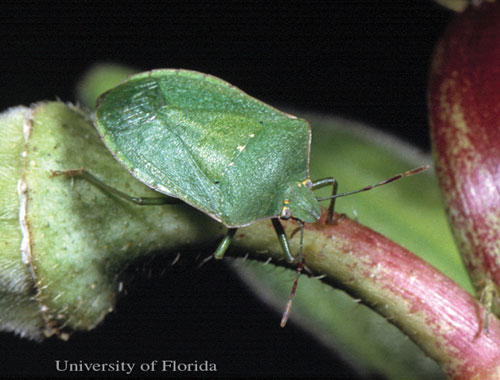 Like aphids and whiteflies, true bugs are sucking insects. True bugs can be recognized by their front wings, which are leathery close to the body but membrane-like at the tips. Nymphs resemble adults in shape but are often colored differently and do not have fully developed wings. Stink bugs are green or brown shield-shaped bugs 1/2 to 2/3 of an inch long. Eggs are barrel-shaped and found on the undersides of leaves in masses of 10 to 50.
Like aphids and whiteflies, true bugs are sucking insects. True bugs can be recognized by their front wings, which are leathery close to the body but membrane-like at the tips. Nymphs resemble adults in shape but are often colored differently and do not have fully developed wings. Stink bugs are green or brown shield-shaped bugs 1/2 to 2/3 of an inch long. Eggs are barrel-shaped and found on the undersides of leaves in masses of 10 to 50.
Leaf-footed bugs are dark-colored true bugs with parallel sides. Eggs are metallic and ovate but somewhat flattened laterally and laid in clusters. Some leaf-footed bugs lay their eggs end-to-end in a single row or chain along a stem or leaf midrib. Nymphs are oblong in shape and red in color, especially on the abdomen.
Nymphs and adults of both stink bugs and leaf-footed bugs suck juices from green fruit leaving a puncture which later may become surrounded by a discolored zone due to invasion of secondary pathogens. Stink bug feeding punctures are often surrounded with a lightened, sometimes depressed, blotch beneath the fruit surface caused by the removal of cell contents and the enzymes injected by the bug. Leaf-footed punctures may cause fruit to become distorted as they enlarge
Tomato Hornworm
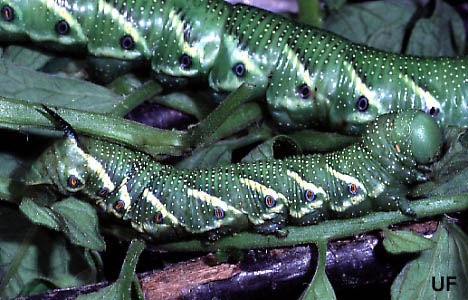 There are many caterpillars that can feed on tomatoes but the tomato hornworm can strip a plant of leaves in a few days. The adult moth is large with mottled brown forewings that are longer than the lighter brown hind wings. The sides of the abdomen have five yellow spots on the sides. The female moth will lay eggs on the upper and lower surfaces of leaves. The adult moths are nectar feeders on many flowers and may be seen in the early evening around gardens and flowers.
There are many caterpillars that can feed on tomatoes but the tomato hornworm can strip a plant of leaves in a few days. The adult moth is large with mottled brown forewings that are longer than the lighter brown hind wings. The sides of the abdomen have five yellow spots on the sides. The female moth will lay eggs on the upper and lower surfaces of leaves. The adult moths are nectar feeders on many flowers and may be seen in the early evening around gardens and flowers.
The emerging caterpillars will feed on leaves and go through several molts as they develop into large green caterpillars with a black ‘horn’ on the tip of the abdomen. Caterpillars are also identified by the white or yellow ‘V’ marks on the sides of the abdomen. When it is time to pupate, the caterpillars drop to the soil and make a cell for changing to the adult moth. The pupa is reddish brown and has a loop structure at the head that contains the mouthparts. There are normally two generations of tomato hornworm a year and as late summer arrives, the hornworm goes through a resting phase.
Other plants in the tomato family can be eaten by tomato hornworms but tomatoes are the favorite in our area. The caterpillars will eat entire leaves and initially work their down on the plant, eating leaves, blossoms, and even green fruit. Because they blend in with green foliage, a homeowner will often overlook the caterpillar despite its large size.
Hornworm does have natural enemies so be cautious before reaching for the insecticide. They can also be easily handpicked and destroyed after you find them.
If you would like further information, please contact the Escambia County Extension office, (850) 475-5230.
United Way Awards Grants To Community Organizations
June 26, 2015
 Thursday, the United Way of Escambia County award over $1.6 million to programs in Escambia County that work to improve the health, education and financial stability outcomes of the area.
Thursday, the United Way of Escambia County award over $1.6 million to programs in Escambia County that work to improve the health, education and financial stability outcomes of the area.
In fiscal year 2014-15, United Way’s campaign totaled $2,190,000, with over half ($1,247,000) was raised by 10 campaigns. The top three workplace campaigns were Gulf Power, Publix Super Markets and Ascend Performance Materials.
United Way Community Investment grants were awarded to:
1 -Year Grant, Education
- Be Ready Alliance for Coordinating Emergencies, Youth Emergency Preparedness – $4,000
- Boys & Girls Clubs of the Emerald Coast, Academic Success – $18,000
- Capstone Adaptive Learning, Capstone Academy Pensacola – $18,000
- Every Child A Reader in Escambia, ReadingPals Program – $13,652
- Gulf Coast Kid’s House, Family Advocacy – $10,000
- Independence for the Blind, Transition Program – $4,000
3 -Year Grant, Education
- Autism Pensacola, Kids for Camp Summer Learning Lab – $19,800
- Big Brothers Big Sisters of Northwest Florida, Community Based Mentoring – $46,426
- Big Brothers Big Sisters of Northwest Florida, Middle School Bigs – $22,000
- Chain Reaction, Chain Reaction – $25,000
- Children’s Home Society of Florida, Teenspace – $16,500
- Pace Center for Girls, Ready through Remediation – $18,000
- YMCA of Northwest Florida, Child Care Program – $44,962
1-Year Grant, Health
- Baptist Healthcare Foundation, Speech & Hearing Board – $4,625
- Boys & Girls Clubs of the Emerald Coast, Healthy Lifestyles – $5,000
- Epilepsy Foundation of Florida, Epilepsy Services and Resource Center – $7,500
- Independence for the Blind, Older Blind Program – $2,000
- Lakeview Center, Rape Crisis/Trauma Recovery Center – $10,000
- Manna Food Bank, Inc., Healthy Seniors Food Program at Westminster Center – $20,000
- Panhandle Youth Assistance Program, Inc., The Leaning Post Ranch – $4,000
3-Year Grant, Health
- Capstone Adaptive Learning and Therapy Centers, Inc., Essential Life Skills – $35,853
- Children’s Home Society, Kugelman Counseling Center – $10,000
- Council on Aging of West Florida, Meals on Wheels – $50,000
- Council on Aging of West Florida, Senior Companion Program – $13,200
- Gulf Coast Kid’s House, Child Abuse Prevention Education – $17,500
- Lutheran Services of Florida, Sexual/Physical Abuse Treatment Program – $36,264
- Manna Food Bank, Inc., Healthy Kids Initiative – $17,366
- New Beginnings, New Beginnings Recovery Homes for Women – $16,275
- The Arc Gateway, Pearl Nelson Center – $73,130
- The Arc Gateway, Supported Living – $10,000
- YMCA of Northwest Florida, Youth Development Program – $24,300
1-Year Grant, Financial Stability
- American Red Cross, Disaster Services – $9,500
- Be Ready Alliance for Coordinating Emergencies, Heritage Oaks – $5,000
- Be Ready Alliance for Coordinating Emergencies, Restoring Hope & Housing – $5,000
- Catholic Charities, Circles NWFL – $15,000
- Catholic Charities, Emergency Assistance Programs – $3,271
- FavorHouse of Northwest Florida, FavorHouse Domestic Violence Shelter Program – $17,500
- Legal Services of North Florida, Independence for Dependent and Homeless Youth – $10,000
- Legal Services of North Florida, Veterans Legal Assistance – $12,500
- The Salvation Army, Social Services/Basic Needs – $40,051
- The Salvation Army, The Salvation Army Emergency Shelter (Sally’s House) – $47,700
3-Year Grant, Financial Stability
- Early Learning Coalition of Escambia County, Early Learning Coalition of Escambia County – $70,000
- United Way 2-1-1 Northwest Florida, United Way 2-1-1 Northwest Florida – $93,808
Perdido Landfill Receives National Award For Coloring Book
June 22, 2015
The Solid Waste Association of North America (SWANA) recently announced that the Escambia County Perdido Landfill has been named the winner of the SWANA Bronze Excellence Award in the Communication, Education and Marketing Tools category. The award will be presented at SWANA’s annual conference on Tuesday, August 25, in Orlando.
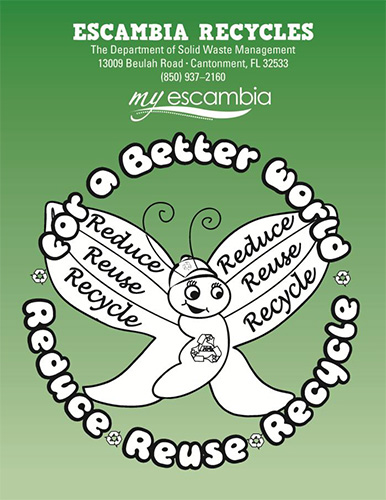 The Escambia County Perdido Landfill is receiving the SWANA award for its “Escambia Recycles Activity and Coloring Book,” a tool that teaches about sustainability, landfills, resources and recycling.
The Escambia County Perdido Landfill is receiving the SWANA award for its “Escambia Recycles Activity and Coloring Book,” a tool that teaches about sustainability, landfills, resources and recycling.
“A few years ago, we looked at the available activity books. They are good tools. Basics about recycling or sustainability in a couple of pages, but we wanted something more in depth and tuned to our program,” said Dee Dee Green, recycling and education outreach coordinator. “We also wanted it to apply to any recycling program in the country.”
This book covers topics, including where does garbage go, the anatomy of a landfill, gas to energy, leachate, alternatives to landfilling solid waste, resources, different types of recycling, electronic and chemical recycling, composting, some green alternatives to chemicals, while also attempting to set a child’s mind in a recycling mode.


